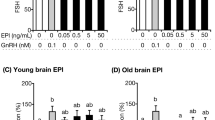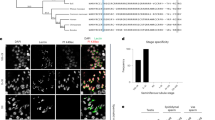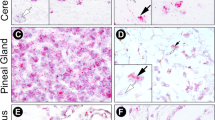Abstract
SPERMIDINE and spermine have recently attracted much interest because of their physical affinity to nucleic acid1–3 and stimulating effect on cell proliferation4–6. These amines occur in high concentrations in actively proliferating tissues such as human semen7, growing chick embryo8, and germinating plant seeds9. These tissues contain a high concentration of deoxyribonucleic acid (DNA). Raina8 has recently found high concentrations of polyamines in the chick embryo which later decreased during incubation. We10 have described the localization of spermine in the cell nucleus using nucleated and non-nucleated blood cells. These findings suggest the importance of polyamines in the growth process of plant and animal tissues.
This is a preview of subscription content, access via your institution
Access options
Subscribe to this journal
Receive 51 print issues and online access
$199.00 per year
only $3.90 per issue
Buy this article
- Purchase on Springer Link
- Instant access to full article PDF
Prices may be subject to local taxes which are calculated during checkout
Similar content being viewed by others
References
Razin, S., and Rozansky, R., Arch. Biochem. Biophys., 81, 36 (1959).
Lee Huang, S., and Felsenfeld, G., Nature, 188, 301 (1960).
Mandel, M., J. Mol. Biol., 5, 435 (1962).
Herbst, E. J., and Snell, E. E., J. Biol. Chem., 181, 47 (1949).
Ham, R. G., Biochem. Biophys. Res. Commun., 14, 34 (1964).
Mager, J., Traub, A., and Grossowicz, N., Nature, 174, 747 (1954).
Harrison, G. A., Biochem. J., 25, 1885 (1931); 27, 1152 (1933).
Raina, A., Acta Physiol. Scand., 60, Suppl. 218 (1963).
Moruzzi, G., and Caldarera, C. M., Arch. Biochem. Biophys., 105, 209 (1964).
Shimizu, H., Kakimoto, Y., and Sano, I., Arch. Biochem. Biophys., 110, 368 (1965).
Shimizu, H., Kakimoto, Y., and Sano, I., J. Pharm. Exp. Therap., 143, 199 (1964).
Schmidt, G., and Thanhauser, S. J., J. Biol. Chem., 161, 83 (1945).
McIlwain, H., in Biochemistry and the Central Nervous System, second ed., edit. by McIlwain, H., 186 (J. and A. Churchill, London, 1959).
Folch-Pi, J., in Biochemistry of the Developing Nervous System, edit. by Waelsch, H., 121 (Academic Press, New York, 1955).
Uzman, L. L., and Rumley, N. K., J. Neurochem., 3, 170 (1958).
Flexner, J. B., and Flexner, L. B., J. Cell. Comp. Physiol., 38, 1 (1951).
Palladin, A. V., in Biochemistry of the Developing Nervous System, edit. by Waelsch, H., 177 (Academic Press, New York, 1955).
Mandel, P., Bleth, R., and Stoll, R., Bull. Soc. Chim. Biol., 31, 1339 (1949).
Author information
Authors and Affiliations
Rights and permissions
About this article
Cite this article
SHIMIZU, H., KAKIMOTO, Y. & SANO, I. Changes in Concentration of Polyamines in the Developing Mouse Brain. Nature 207, 1196–1197 (1965). https://doi.org/10.1038/2071196a0
Published:
Issue Date:
DOI: https://doi.org/10.1038/2071196a0
This article is cited by
-
Spermine binding to subsynaptosomal fractions of rat brain cortex
Neurochemical Research (1988)
-
Beziehungen zwischen Polyaminen und Nucleinsäuren
Histochemie (1973)
-
Putrescine and polyamines in relation to nucleic acids in mouse liver after partial hepatectomy
Virchows Archiv B Cell Pathology (1971)
Comments
By submitting a comment you agree to abide by our Terms and Community Guidelines. If you find something abusive or that does not comply with our terms or guidelines please flag it as inappropriate.



